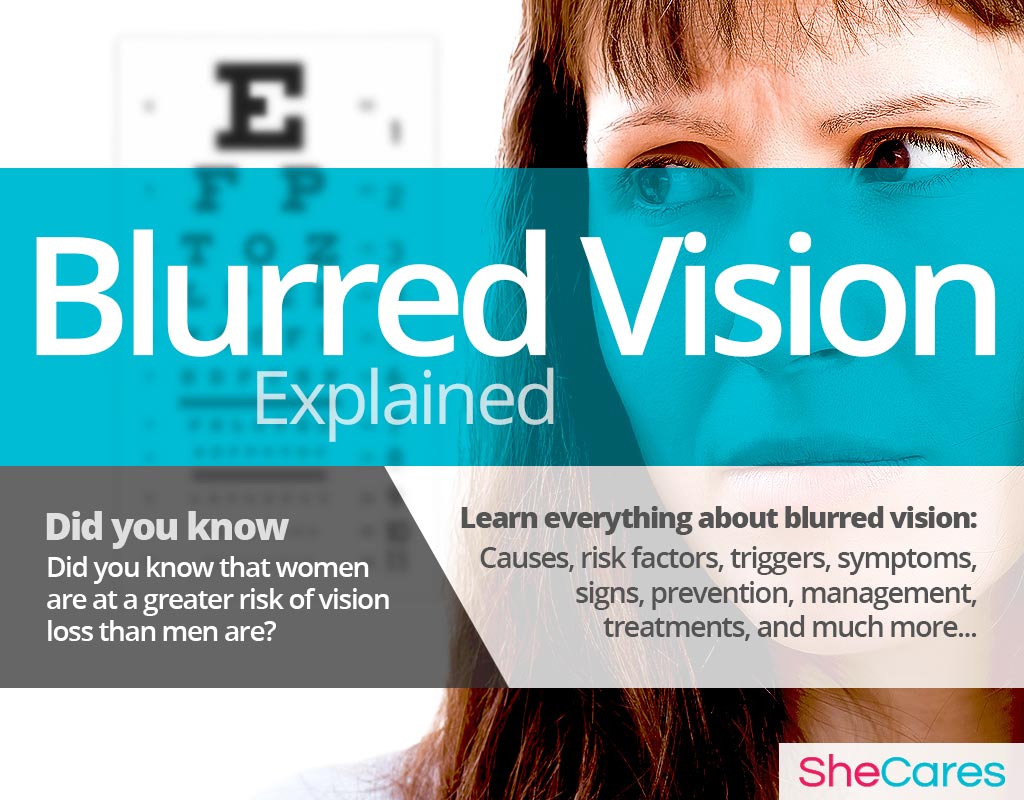About
Quick Facts about Blurred Vision
- Women are at a greater risk of vision loss than men are.
- Around 82% of people with some kind of visual impairment are over age 50.
- A common cause of blurry vision is refraction problems, which can be corrected with glasses or contacts. Hormonal imbalances and other damage to the eye can also cause changes in vision.
Blurred vision, the most commonly reported eye problem, is a type of visual impairment that affects the sharpness or focus of an image. Many parts of the eye contribute to producing a clear image, and since an issue with any one of these parts can result in blurriness, it is important to have a clear picture of how the eye functions in order to understand what part may be affected and how to best treat it.
Changes in the cornea, or the clear “window” in the center of the eye, affect how the image is brought into focus and how light enters the eye. The blood vessels and capillaries (tiny vessels that feed tissues) carry nutrients to the eye, but they can become blocked or leaky. Pressure of the liquid inside the eye (vitreous humor) can influence the production of an image or obscure the retina, the inner tissue that receives light and makes the picture. In particular, the macula is the part of the retina that is responsible for high-resolution vision. The lens, along with the cornea, is the part that refracts the light that is focused onto the retina, much like a camera lens brings an image into focus. A problem with the tear glands or the secretion of tears may cause eyes to become dry or dirty, causing irritation or blurriness. Finally, the damage to the optic nerve may affect how the image is sent to the brain and rendered there.
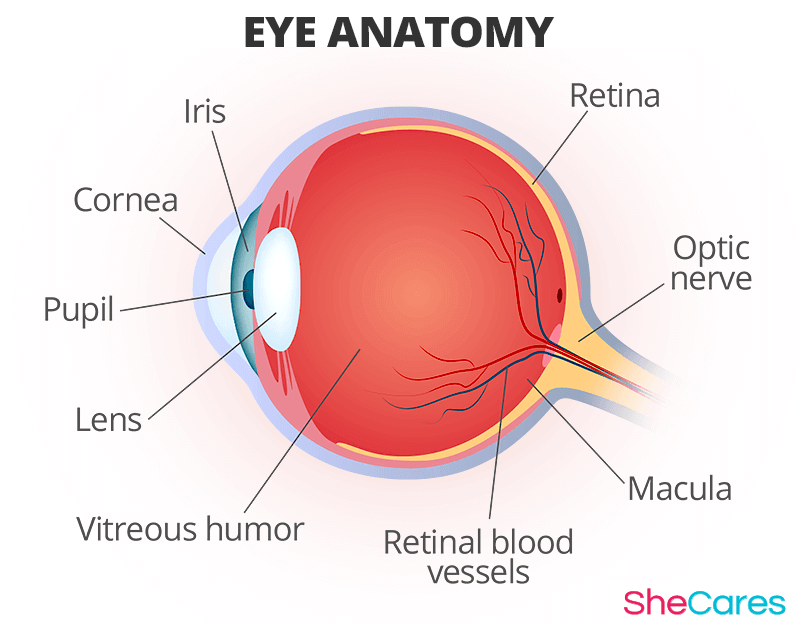
While there are many factors and disorders that can affect any number of these ocular structures and result in blurry vision, abnormal hormone levels are an often-overlooked culprit. These levels can become especially unbalanced during different stages of a woman's reproductive life, namely puberty, pregnancy, post-partum (and breastfeeding), and menopause.
Identifying Blurred Vision
Many women experience blurring of vision differently, depending greatly on the cause behind the eyesight problems. However, describing the frequency and intensity of the blurriness helps in identifying fuzzy vision and how it varies.
To understand the mechanisms of blurriness and determine which part of the eye is affected, continue reading about the hormonal and non-hormonal causes of blurred eyes.
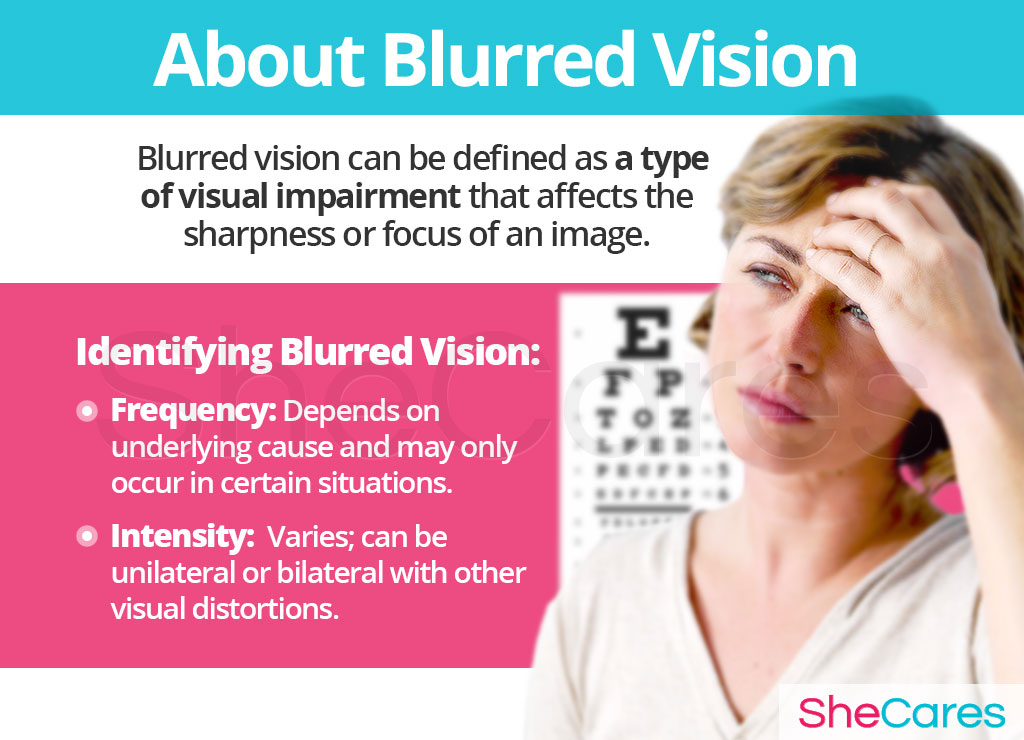
Causes
In order to be able to manage or prevent visual impairment, it is essential to understand the cause behind it. While there are many possible causes of blurred eyes and not all of them are fully understood, in many cases hormonal fluctuations - a factor that is often overlooked - may induce vision problems. Other medical conditions and anatomical abnormalities may also result in blurriness, or it could be a combination of those factors.
Continue reading to learn more about both the hormonal and additional causes of blurry eyes.
Hormonal Causes of Blurred Vision
Hormones are chemical messengers in the body that send signals and regulate many functions of the organs, tissues, and cells. Researchers have confirmed the presence of sex hormone receptors in the tissue of the eye, indicating that estrogen, progesterone, and testosterone regulate functions there as well. In addition, hormones regulate the production and composition of tears, which can also have an effect on vision.
Progesterone excess in particular has a known effect on vision. In fact, all 13 of the leading progesterone pharmaceuticals (oral, topical, and inserts) list blurred vision or the more general “distortions in vision” as a side effect. In addition, estrogen plays in role in regulating water retention and blood vessel dilation. So an imbalance of that hormone can affect the shape of the cornea and how blood moves through the eye, potentially causing blurriness.
Therefore, changes in the levels of estrogen and progesterone, which are most likely to happen at certain points in the menstrual cycle and during life phases of hormonal fluctuation - puberty, pregnancy, post-partum, and menopause - are most likely the cause of blurry eyes during the aforementioned times.
In addition, there are other factors that emerge during certain stages of a woman's reproductive life that can contribute to blurry vision alongside the hormonal causes. See the boxes below to find out more about the occurrence of blurriness around PMS and during puberty, pregnancy, post-partum, and menopause.
Hormonal Causes during Different Phases in a Woman's Life
PMS, or premenstrual syndrome, is group of symptoms that arise shortly before and during menstruation. Blurred vision is one such symptom, and it may be linked to other PMS symptoms as well.
Puberty is when a girl's body starts producing reproductive hormones and begins to develop. These hormonal changes, in addition to other factors during puberty like rapid growth and migraines, can also contribute to blurred vision.
Pregnancy is a time of drastic hormonal fluctuation that produces many changes in the body in order to support the growing baby. These changes, such as dry eyes and water retention, may result in blurry vision. However, in rare cases, blurred eyes can be a sign of a pregnancy complication.
Post-partum and breastfeeding is another stage in which levels of reproductive differ from the norm, especially after the sharp increase during pregnancy. These hormonal and subsequent physical changes also have an effect on vision after delivery.
Menopause refers to the transitional stage in which levels of reproductive hormones naturally decline in preparation for the end of menstruation and fertility. These hormonal changes, which trigger other menopausal symptoms, can have an effect on vision.
Other Less Common Causes of Blurred Vision
Although hormonal imbalances are often the underlying cause of blurry vision, other conditions and damage to the eye may also distort eyesight, especially as women get older. These disorders, for the most part, are less common but more serious. They include conditions such as glaucoma, diabetic eye disease, and refractive problems, among others.
Read on to find out more about the risk factors and triggers that can influence a woman's experience of blurry eyes.
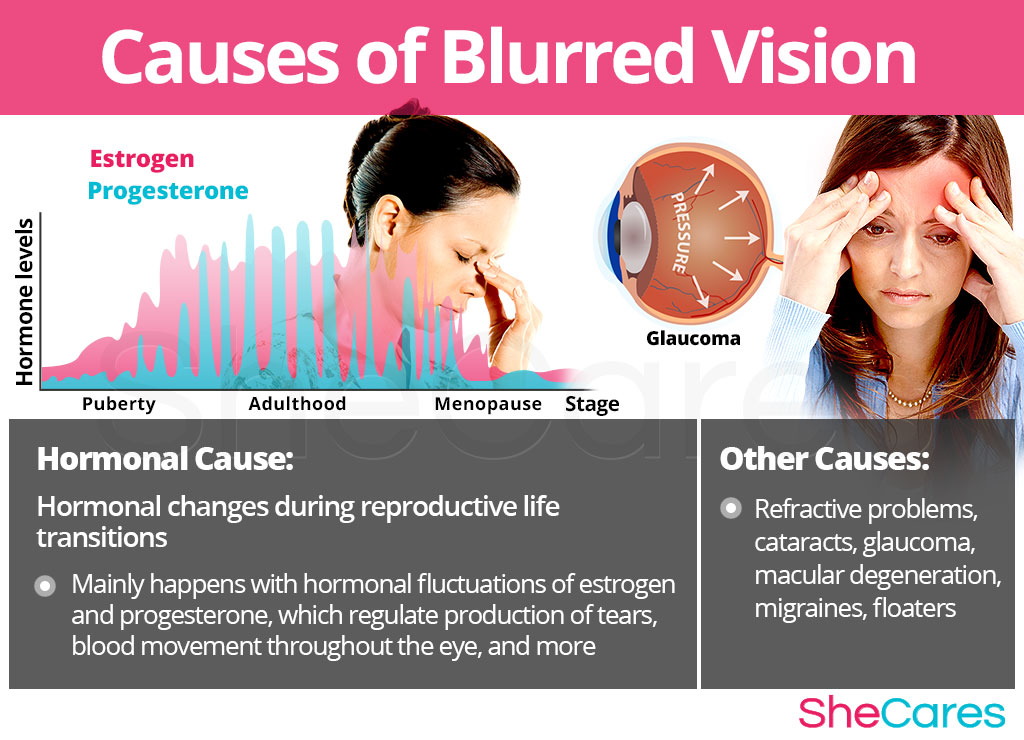
Risk Factors and Triggers
Risk Factors for Blurred Vision
Due to certain internal and external factors, some women may be more likely to develop blurred vision or experience periods of fuzzy vision than others may. These reasons include certain medications, diabetes, past injury, and others.
Triggers of Blurred Vision
There are other triggers, such as anxiety attacks, that can provoke episodes of blurry vision. Avoiding these as much as possible will greatly reduce the experience of impaired vision.
Read on to learn about the signs and symptoms of blurry vision and how the disorder is diagnosed.
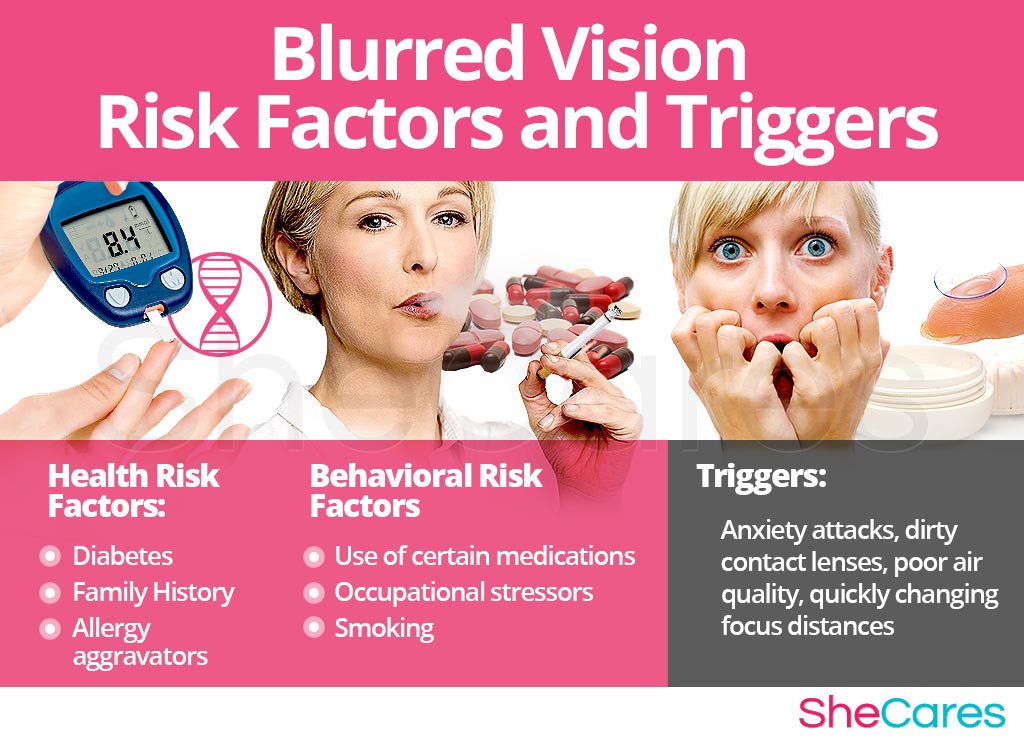
Signs and Symptoms
While each individual woman may experience blurry eyes differently depending on the cause and her stage in life, there are some symptoms that nearly all women experience regarding blurriness.
Common Symptoms of Blurred Vision
- Inability to see clearly
- Trouble focusing either up close or on distant objects
- Gradual loss in the sharpness of vision
Signs of Blurred Vision
As opposed to the symptoms experienced by the patient, medical signs are measurable criteria used by a doctor or ophthalmologist in order to access the severity of the impairment. The following signs may be considered in the diagnosis of vision problems:
- A diopter prescription of more than +1.00 (farsightedness) or less than -1.00 (nearsightedness)
- Eye pressure of 22 mm Hg or more (for glaucoma and ocular hypertension)
- 20/32 vision or worse (a second number greater than 32)
- A visual acuity score of 90 or less
Diagnosis of Blurred Vision
In order to detect blurred vision and diagnose the underlying cause, an ophthalmologist or optometrist typically performs three actions: a review of the patient's medical history and a physical eye exam, which often includes a series of additional tests.
Complications of Blurred Vision
In rare cases, changes in vision that go untreated can result in certain complications that pose a danger for eyesight. However, in many cases, blurry vision will not need surgery or serious medical intervention. The possible but uncommon complications of blurred vision include permanent vision impairment and blindness, but before it reaches that point, there are specific warning signs.
Women who periodically experience episodes of blurry vision may want to learn how to best manage them or prevent them from occurring in the future. Continue reading to find out more about practical techniques for preventing and managing blurry eyes.
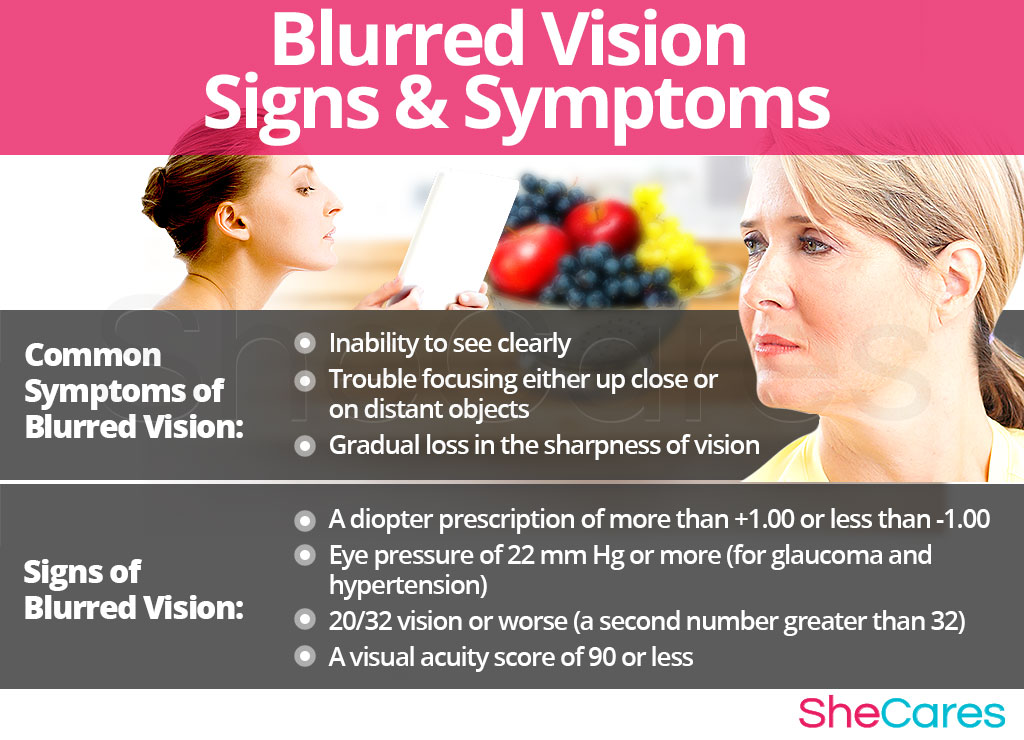
Prevention and Management
Preventing Blurred Vision
There is no guaranteed way to prevent vision changes, just as there is no way to hold back hormonal fluctuations or natural aging. Nonetheless, there are some measures a woman can take to reduce the chances of developing blurry eyes or other vision problems, or to lessen the frequency or intensity of the blurriness.
Lifestyle changes, including those regarding diet, exercise, and healthy habits, are very significant in preventing eye problems. In addition, supplements that enhance the endocrine system are often sought to compliment this lifestyle changes, especially when the blurriness is due to a hormonal imbalance.
Women already experiencing blurry eyes may wish to manage their vision problems. Fortunately, there are many ways to improve compromised vision; keep reading to learn more about these management methods.
Managing Blurred Vision
Even when blurry vision has already set in, and whether it is situational or continual, there are effective ways to manage blurriness. Avoiding triggers and making some simple changes can make vision crystal clear again.
These are general tips that all women can use to reduce or fully manage blurry vision. They include elements like eyewear, drops, and taking breaks.
Alternative Management Tips for Blurred Vision
Alternative management techniques, such as acupuncture and eye exercises, may also provide relief for symptoms of vision problems. However, it is important to note that these methods, for the most part, do not address the underlying hormonal imbalance or structural issue that may be causing blurred eyes.
While these techniques may help to reduce blurriness, they do not address the root of the problem, which in some cases is hormonal imbalance. However, there are natural treatments that focus on the hormonal causes of blurred vision as well as additional treatments for more severe eye problems. Continue reading to learn more about the three approaches to treating blurry eyes.
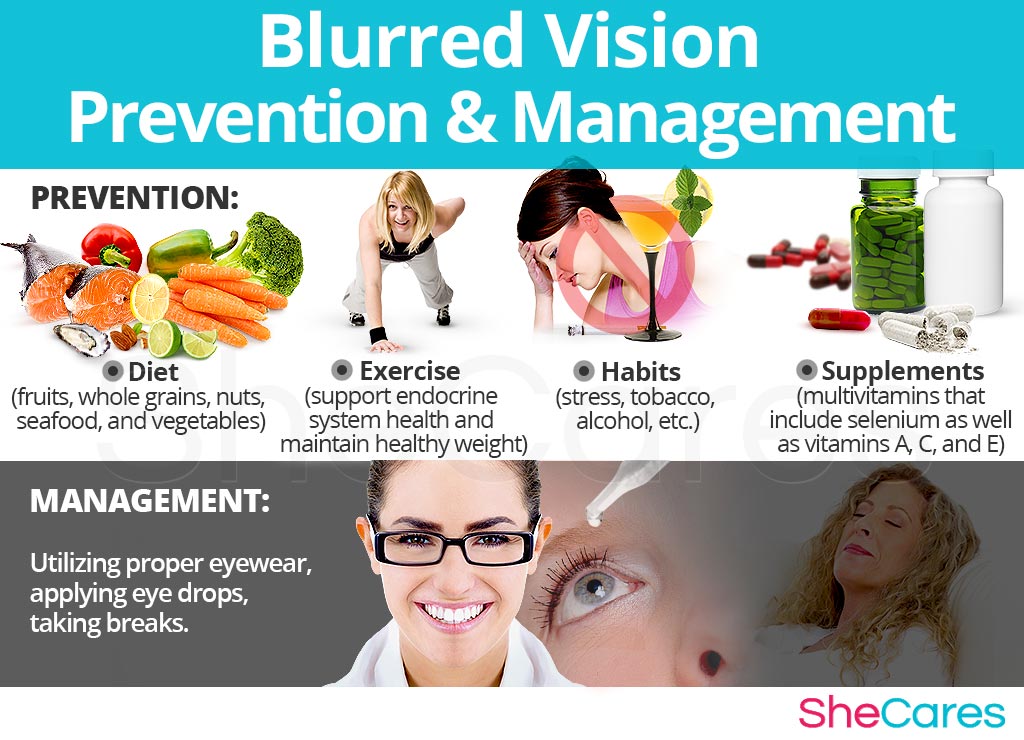
Treatments
Blurry vision can be frustrating and disruptive for any woman who experiences it; it can even interfere with daily life. Therefore, many may wish to find an appropriate and effective treatment according to the cause of their eyesight woes.
Three Approaches to Treat Blurred Vision
Three tiers of approaches can be considered for treating blurry vision. These are defined as: (1) Lifestyle Changes, (2) Alternative Medicine, and (3) Pharmaceutical and Surgical Options.
Women are urged to start with the least risky approach to treating blurry vision: lifestyle adjustments. From there, if they don't experience relief, they should then proceed to the next tier. Medical intervention is not usually needed to treat blurry eyes, but women may wish to consider pharmaceutical and surgical options as a last resort after properly assessing the associated risks.
Lifestyle Changes for Blurred Vision
The first tier of treatment entails the least amount of risk, but it also demands the most self-discipline. In many cases, simple lifestyle changes can have a profound positive effect on health and in combating blurry vision. These changes essentially consist of diet, exercise, and healthy habits.
These changes may help relieve symptoms in minor cases of blurred vision, but they do not directly address hormonal imbalance or any other underlying cause behind blurry eyes. So, additional treatment may be needed. In that vein, alternative medicine can be a safe and natural way of treating blurry vision, especially when it appears at times of hormonal imbalance.
Alternative Medicine for Blurred Vision
Alternative treatments and supplements involve very little or no risk, and they can be a very effective way for treating blurred vision that is due to a hormonal imbalance. The main type of herbal substances that may be taken are hormone-regulating herbal supplements.
These supplements, such as Macafem, promote natural hormone production in the body by nourishing the endocrine system and helping it produce hormones more efficiently and at the right levels. This results in balance of not only estrogen, but also other hormones like progesterone.
This kind of supplement is the safest and most natural way to treat symptoms of underlying hormonal imbalance, and it can be taken at any stage throughout a woman's life because it supports natural hormone production.
In addition, other types of supplements can provide relief for blurred vision or at least make it more manageable, including vitamins and other herbal supplements.
A combination of the first two tiers is usually the most effective treatment plans. In other words, lifestyle changes combined with alternative medicine is often provides the most relief for blurry vision. However, in cases of a more severe eye issue, drugs or surgery may be necessary.
Pharmaceutical and Surgical Options for Blurred Vision
Treatments on the third tier contain the highest risk and usually the greatest costs as well. Not all treatments may be used at all stages in life, and the appropriate treatment depends entirely on the underlying cause and how severely it has progressed, as well as the part of the eye that is damaged and causing the blurry vision. Therefore, treatments on this tier tend to be very specific to the patient's case and needs.
In medically treating blurred vision, there are two main possibilities: pharmaceutical and surgical options.
The three tiers of treatment - lifestyle changes, alternative medicine, and medical options - are not mutually exclusive. A woman may choose to use different approaches at different times or a combination thereof, depending on the intensity of the symptoms and their underlying cause. More and more women are finding that a blend of lifestyle adjustments and herbal supplements are the best way to combat symptoms of hormonal imbalance.
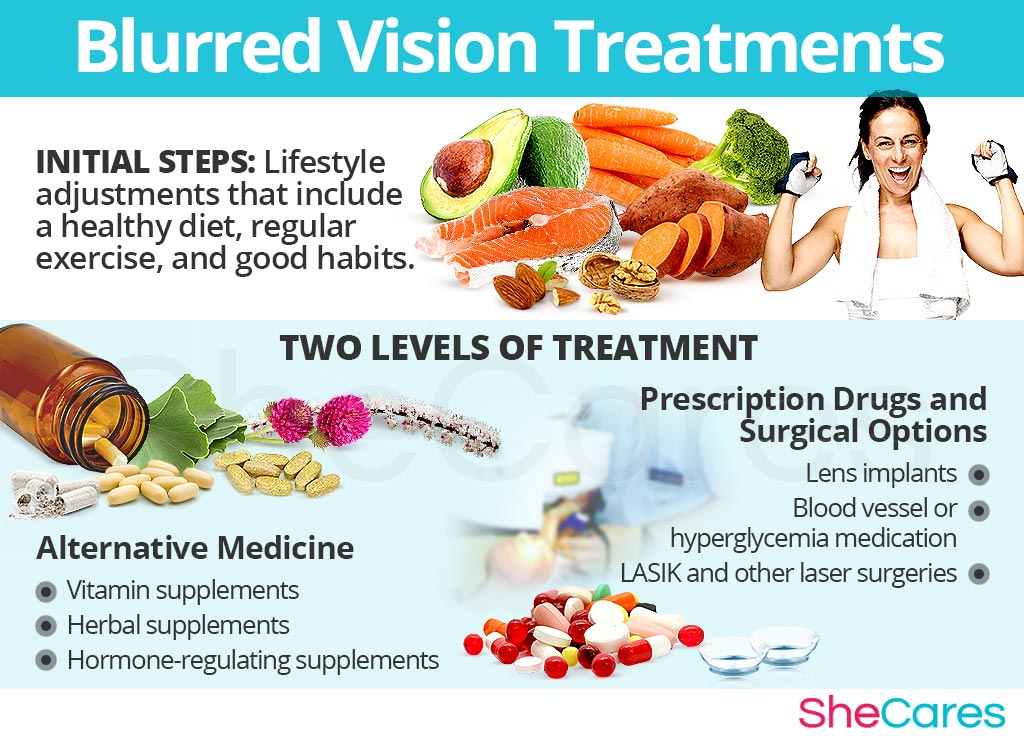
Sources
- American Optometric Association. (n.d.). Vitamin C. Retrieved October 19, 2017, from https://www.aoa.org/patients-and-public/caring-for-your-vision/diet-and-nutrition/vitamin-c
- Centers for Disease Control and Prevention. (2015). Vision Health Initiative (VHI). Retrieved October 19, 2017, from http://www.cdc.gov/visionhealth/data/national.htm
- Cho, L. (2014). Estrogen & Hormones. Retrieved October 19, 2017, from http://my.clevelandclinic.org/heart/prevention/estrogen-hormones/default.aspx
- Fuchsjäger-Mayrl, G. et al. (2002). Identification of Estrogen and Progesterone Receptor mRNA Expression in the Conjunctiva of Premenopausal Women. Investigative Ophthalmology & Visual Science, 43(9), 2841-2844. Retrieved October 19, 2017, from www.iovs.org/content/43/9/2841.full.pdf
- Glaucoma Research Foundation. (2016). High Eye Pressure and Glaucoma. Retrieved October 19, 2017, from http://www.glaucoma.org/gleams/high-eye-pressure-and-glaucoma.php
- Harvard Health Publishing. (n.d.). The lowdown on eye exercises | Safeguarding your sight. Retrieved October 18, 2017, from https://www.health.harvard.edu/diseases-and-conditions/the-lowdown-on-eye-exercises | https://www.health.harvard.edu/healthbeat/safeguarding-your-sight --- reading in dim light, carrots, computer screen
- Mayo Clinic Staff. (2015). Cataracts | Diabetic retinopathy | Glaucoma | Dry macular degeneration | Nearsightedness | Postpartum preeclampsia | Wet macular degeneration. Retrieved July 19, 2013 from http://www.mayoclinic.com/health/cataracts/DS00050/DSECTION=treatments%2Dand%2Ddrugs | http://www.mayoclinic.com/health/diabetic-retinopathy/DS00447/DSECTION=treatments%2Dand%2Ddrugs | http://www.mayoclinic.com/health/glaucoma/DS00283/DSECTION=treatments%2Dand%2Ddrugs | http://www.mayoclinic.com/health/macular-degeneration/DS00284/DSECTION=treatments%2Dand%2Ddrugs | http://www.mayoclinic.com/health/nearsightedness/DS00528/DSECTION=lifestyle%2Dand%2Dhome%2Dremedies | http://www.mayoclinic.com/health/postpartum-preeclampsia/DS01199 | http://www.mayoclinic.com/health/wet-macular-degeneration/DS01086
- National Institutes of Health. (2017). Vision problems | Presbyopia. Retrieved October 19, 2017, from https://medlineplus.gov/ency/article/003029.htm | https://medlineplus.gov/ency/article/001026.htm
- New York State Department of Health. (2012). Types of Vision Problems. Retrieved October 19, 2017, from http://www.health.ny.gov/diseases/conditions/vision_and_eye_health/types_of_vision_problems.htm
- Prevent Blindness. (n.d.). Pregnancy and Your Vision. Retrieved October 19, 2017, from https://www.preventblindness.org/pregnancy-and-your-vision
